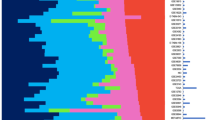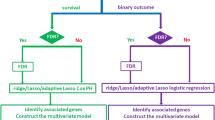Abstract
Tumours are complex biological systems. No single type of molecular approach fully elucidates tumour behaviour, necessitating analysis at multiple levels encompassing genomics and proteomics. Integrated data sets are required to fully determine the contributions of genome alterations, host factors and environmental exposures to tumour growth and progression, as well as the consequences of interactions between malignant or premalignant cells and their microenvironment. The sheer amount and heterogeneous nature of data that need to be collected and integrated are daunting, but effort has already begun to address these obstacles.
This is a preview of subscription content, access via your institution
Access options
Subscribe to this journal
Receive 12 print issues and online access
$209.00 per year
only $17.42 per issue
Buy this article
- Purchase on Springer Link
- Instant access to full article PDF
Prices may be subject to local taxes which are calculated during checkout



Similar content being viewed by others
References
Tapon, N. Modeling transformation and metastasis in Drosophila. Cancer Cell 4, 333–335 (2003).
Rangarajan, A. & Weinberg, R. A. Comparative biology of mouse versus human cells: modelling human cancer in mice. Nature Rev. Cancer 3, 952–359 (2003).
Lamb, J. et al. A mechanism of cyclin D1 action encoded in the patterns of gene expression in human cancer. Cell 114, 323–334 (2003).
Creighton, C. et al. Profiling of pathway-specific changes in gene expression following growth of human cancer cell lines transplanted into mice. Genome Biol. 4, R46 (2003).
Albertson, D. G., Collins, C., McCormick, F. & Gray, J. W. Chromosome aberrations in solid tumors. Nature Genet. 34, 369–376 (2003).
Albertson, D. G. & Pinkel, D. Genomic microarrays in human genetic disease and cancer. Hum. Mol. Genet. 2, R145–R152 (2003).
Shi, H. et al. Triple analysis of the cancer epigenome: an integrated microarray system for assessing gene expression, DNA methylation, and histone acetylation. Cancer Res. 63, 2164–2171 (2003).
Feltus, F. A., Lee, E. K., Costello, J. F., Plass, C. & Vertino, P. M. Predicting aberrant CpG island methylation. Proc. Natl Acad. Sci. USA 100, 12253–12258 (2003).
Ntzani, E. E. & Ioannidis, J. P. Predictive ability of DNA microarrays for cancer outcomes and correlates: an empirical assessment. Lancet 362, 1439–1444 (2003).
Simon, R. Diagnostic and prognostic prediction using gene expression profiles in high-dimensional microarray data. Br. J.Cancer 89, 1599–1604 (2003).
Rhodes, D. R. et al. Large-scale meta-analysis of cancer microarray data identifies common transcriptional profiles of neoplastic transformation and progression. Proc. Natl Acad. Sci. USA 101, 9309–9314 (2004).
Lieberfarb, M. E. & Lin, M. Genome-wide loss of heterozygosity analysis from laser capture microdissected prostate cancer using single nucleotide polymorphic allele (SNP) arrays and a novel bioinformatics platform dChipSNP. Cancer Res. 63, 4781–4785 (2003).
Pollack, J. R. et al. Microarray analysis reveals a major direct role of DNA copy number alteration in the transcriptional program of human breast tumors. Proc. Natl Acad. Sci. USA 99, 12963–12968 (2002).
Wu, R. et al. Amplification and overexpression of the L-MYC proto-oncogene in ovarian carcinomas. Am. J. Pathol. 162, 1603–1610 (2003).
Hanash, S. Disease proteomics. Nature 422, 226–232 (2003).
Ruggero, D. & Pandolfi, P. P. Does the ribosome translate cancer? Nature Rev. Cancer 3, 179–192 (2003).
Inoki, K., Zhu, T. & Guan, K. L. TSC2 mediates cellular energy response to control cell growth and survival. Cell 115, 577–590 (2003).
Nishizuka, S. & Charboneau, L. Proteomic profiling of the NCI-60 cancer cell lines using new high-density reverse-phase lysate microarrays. Proc. Natl Acad. Sci. USA 100, 14229–14234 (2003).
Beer, D. G. et al. Gene-expression profiles predict survival of patients with lung adenocarcinomas. Nature Med. 8, 816–824 (2002).
Chen, G. et al. Protein profiles associated with survival in lung adenocarcinoma. Proc. Natl Acad. Sci. USA 100, 13537–13542 (2003).
Brichory, F. M. et al. An immune response manifested by the common occurrence of annexins I and II autoantibodies and high circulating levels of IL-6 in lung cancer. Proc. Natl Acad. Sci. USA 98, 9824–9829 (2001).
Albert, P. S. & Shih, J. H. Modeling tumor growth with random onset. Biometrics 59, 897–906 (2003).
Telford, J. J., Saltzman, J. R., Kuntz, K. M. & Syngal, S. Impact of preoperative staging and chemoradiation versus postoperative chemoradiation on outcome in patients with rectal cancer: a decision analysis. J. Natl Cancer Inst. 96, 191–201 (2004).
Merlino, G. & Noonan, F. P. Modeling gene-environment interactions in malignant melanoma. Trends Mol. Med. 9, 102–108 (2003).
Semenza, G. L. Targeting HIF-1 for cancer therapy. Nature Rev. Cancer 3, 721–732 (2003).
Kanehisa, M., Goto, S., Kawashima, S. & Nakaya, A. The KEGG databases at GenomeNet. Nucleic Acids Res. 30, 42–46 (2002).
Doniger, S. W. et al. MAPPFinder: using Gene Ontology and GenMAPP to create a global gene-expression profile from microarray data. Genome Biol. 4, R7 (2003).
Ashburner, M. et al. Gene ontology: tool for the unification of biology. The Gene Ontology Consortium. Nature Genet. 25, 25–29 (2000).
Schacherer, F. et al. The TRANSPATH signal transduction database: a knowledge base on signal transduction networks. Bioinformatics 17, 1053–1057 (2001).
Koike, A., Kobayashi, Y. & Takagi, T. Kinase pathway database: An integrated protein-kinase and NLP-Based protein-interaction resources. Genome Res. 13, 1231–1243 (2003).
Bader, G. D., Betel, D. & Hogue, C. W. BIND: The biomolecular interation network database. Nucleic Acids Res. 31, 248–250 (2003).
Xenarios, I. et al. DIP, the Database of Interacting Proteins: a research tool for studying cellular networks of protein interactions. Nucleic Acids Res. 30, 303–305 (2002).
Gelovani-Tjuvajev, J. & Blasberg, R. In vivo imaging of molecular-genetic targets for cancer therapy. Cancer Cell 4, 327–333 (2003).
Zerhouni, E. The NIH Roadmap. Science 302, 63–72 (2003).
Wheeler, D. L. et al. Database resources of the National Center for Biotechnology Information: update. Nucleic Acids Res. 32 (Database issue), D35–D40 (2004).
Covitz, P. A. et al. caCORE: A common infrastructure for cancer informatics. Bioinformatics 19, 2404–2412 (2003).
Zeeberg, B. R. et al. GoMiner: a resource for biological interpretation of genomic and proteomic data. Genome Biol. 4, R28 (2003).
Author information
Authors and Affiliations
Ethics declarations
Competing interests
The author declares no competing financial interests.
Related links
Related links
DATABASES
Cancer.gov
Entrez Gene
FURTHER INFORMATION
Biomolecular Interaction Database
Cancer Biomedical Informatics Grid
Database of Interacting Proteins
DBCAT, The Public Catalog of Databases
Director's Challenge initiative
Early Detection Research Network
European Bioinformatics Institute
Human Protein Reference Database
Kyoto Encyclopedia of Genes and Genomes
Mouse Models of Human Cancers Consortium
National Cancer Institute Gene Expression Data Portal
National Cancer Research Institute Cancer Informatics web site
National Center for Biotechnology Information
Rights and permissions
About this article
Cite this article
Hanash, S. Integrated global profiling of cancer. Nat Rev Cancer 4, 638–644 (2004). https://doi.org/10.1038/nrc1414
Issue Date:
DOI: https://doi.org/10.1038/nrc1414
This article is cited by
-
Min-redundancy and max-relevance multi-view feature selection for predicting ovarian cancer survival using multi-omics data
BMC Medical Genomics (2018)
-
Identification of epigenetic interactions between miRNA and DNA methylation associated with gene expression as potential prognostic markers in bladder cancer
BMC Medical Genomics (2017)
-
Systems-level effects of ectopic galectin-7 reconstitution in cervical cancer and its microenvironment
BMC Cancer (2016)
-
BMRF-MI: integrative identification of protein interaction network by modeling the gene dependency
BMC Genomics (2015)
-
Single-band upconversion nanoprobes for multiplexed simultaneous in situ molecular mapping of cancer biomarkers
Nature Communications (2015)



